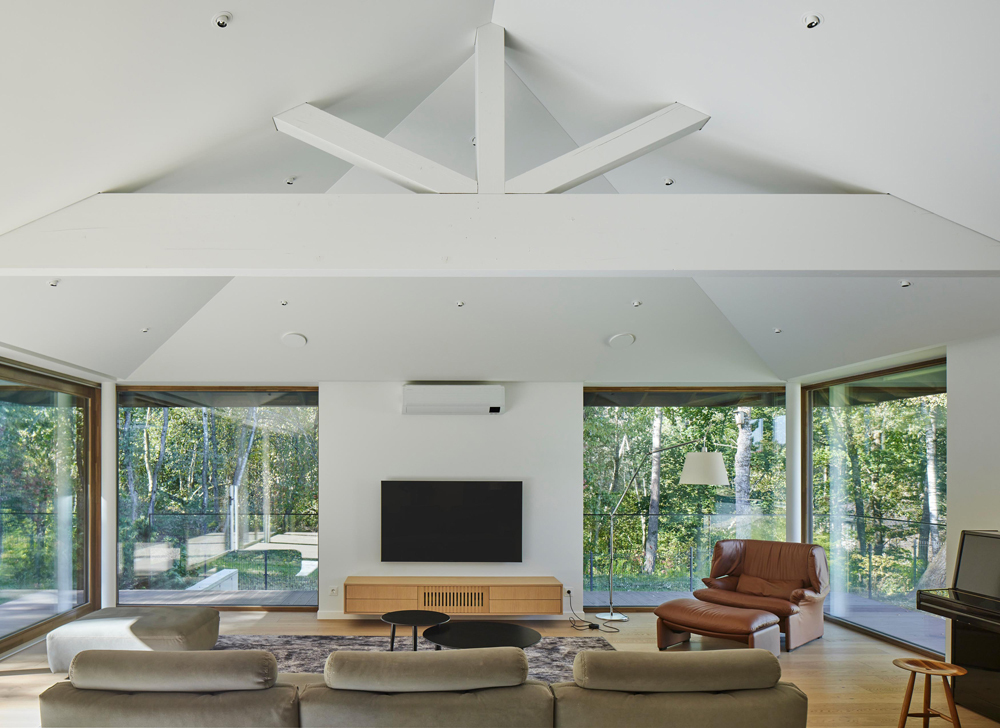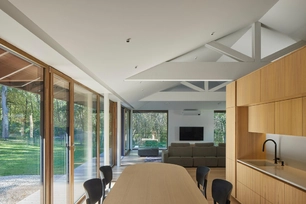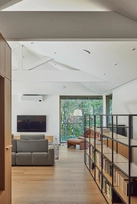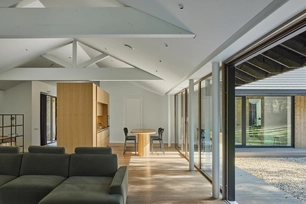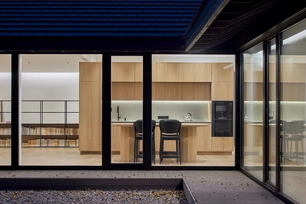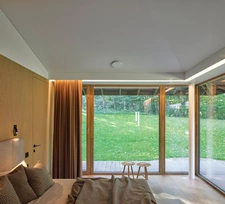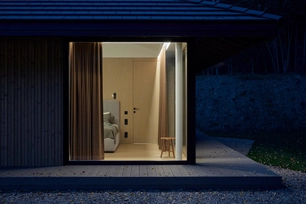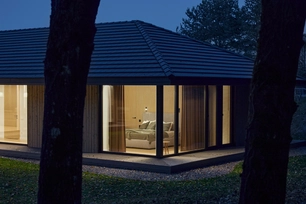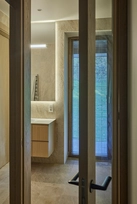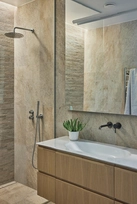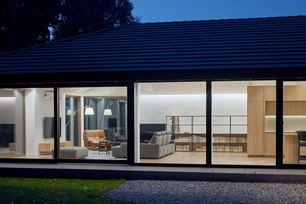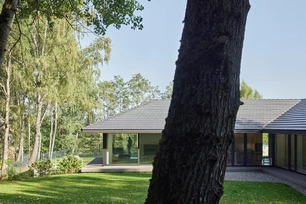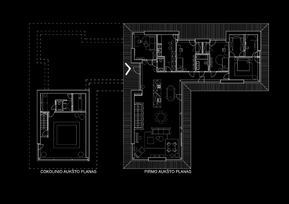Apie projektą:
Šalis: Lietuva
Plotas: 300 m2
Miško atspindžiai
Daugeliu atvejų labai svarbu, kad tiek namo architektūra, tiek kraštovaizdis, tiek ir interjeras būtų stilistiškai vieningi. Šio projekto atveju dalyvavome visame namo kūrimo procese: nuo namo architektūros formavimo iki interjero detalių. Tad namo vidus buvo pradėtas planuoti jau nuo pirmų architektūrinių projektinių pasiūlymų, o tai iš esmės palengvino visą vėlesnį vidaus patalpų įrengimo procesą. Sklypą nuo pietrytinės iki šiaurės vakarinės pusės įrėmina brandžių medžių miškas. Namas yra L formos ir kartu su miško kontūru formuoja privatų vidinį kiemą. Gamtinė aplinka tiesiog diktavo namo pietinį ir vakarinį fasadus plačiai atverti miškui, tad stiklinės atitvaros ta kryptimi atrodė tarsi savaime suprantamas dalykas. Kai pagrindiniu interjero akcentu pasirenkamas kintantis gamtovaizdis, kuris atsiveria pro didelius namo langus, tai baldai, šviestuvai ir kitos detalės tiesiog privalo mandagiai papildyti visumą, kad namuose vyrautų harmonija ir ramybė. Darnos su gamta ir aplinka idėjos itin aiškiai išreiškiamos japonų architektūros kalboje, kurioje nuosaikumas bei minimalizmas yra vienos pagrindinių sąvokų. Šios idėjos mus inspiravo ir vedė viso kūrybinio proceso metu, kurio rezultatas simboliškai atspindi ramybę ir namų jaukumą.
Forest reflections
In most cases it is very important that the architecture of the house, the landscape, and the interior are stylistically unified. In the case of this project we participated in the entire process of building the house. From the design of the house's architecture to the interior details. Therefore, the interior of the house was started to be planned from the first architectural design proposals, which essentially facilitated the entire subsequent process of interior design. The plot is framed by a forest of mature trees from the southeast to the northwest. The house is L-shaped and together with the contour of the forest forms a private courtyard. The natural environment simply dictated to open the southern and western facades of the house wide to the forest, so the glass partitions in that direction seemed like a matter of course. When the main focus of the interior is the changing scenery, then furniture, lighting and other interior details simply must be politely calm, so that forest harmony and peace prevail in the house. The ideas of harmony with nature and the environment are very clearly expressed in the language of Japanese architecture, where moderation and minimalism are one of the main concepts. These ideas inspired and guided us throughout the creative process, the result of which symbolically reflects the peace and comfort of this home.
Nuotraukos: Norbert Tukaj
© 2025 visos teisės saugomos
Norėdami išsaugoti, prisijunkite.
Siekdami užtikrinti geriausią Jūsų naršymo patirtį, šiame portale naudojame slapukus.
Daugiau informacijos ir pasirinkimo galimybių rasite paspaudus mygtuką „Nustatymai“.
Jei ateityje norėsite pakeisti šį leidimą, tą galėsite bet kada galėsite padaryti paspaudžiant portalo apačioje esančią „Slapukų nustatymai“ nuorodą.
Tai portalo veikimui būtini slapukai, kurie yra įjungti visada. Šių slapukų naudojimą galima išjungti tik pakeitus naršyklės nuostatas.
| Pavadinimas | Aprašymas | Galiojimo laikas |
|---|---|---|
| storage_consent | Šiame slapuke išsaugoma informacija, kurias šiuose nustatymuose matomų slapukų grupes leidžiate naudoti. | 365 dienos |
| PHPSESSID | Sesijos identifikacinis numeris, reikalingas bazinių portalo funkcijų (pavyzdžiui, galimybei prisijungti, užildyti užklausos formą ir kitų) veikimo užtrikinimui. | Iki naršyklės uždarymo |
| REMEMBERME | Prisijungimui prie asmeninės paskyros portale naudojamas slapukas. | 1 mėnuo |
| OAID | Portalo vidinės reklaminių skydelių valdymo sistemos slapukas. | 1 metai |
| __eoi | Saugumo paskirtį atliekantis Google paslaugose (Google AdSense, AdSense for Search, Display & Video 360, Google Ad Manager, Google Ads) naudojamas slapukas. | 6 mėnesiai |
| sender_popup_shown_* | Naujienlaiškio užsakymo formos nustatymai. | 1 mėnuo |
Slapukai skirti informacijos apie portalo lankomumą rinkimui.
| Pavadinimas | Aprašymas | Galiojimo laikas |
|---|---|---|
| _ga | Google Analytics statistikos slapukas | 2 metai |
| _ga_* | Google Analytics statistikos slapukas | 2 metai |
Rinkodaros arba reklamos slapukai, kurie naudojami siekiant parodyti pasiūlymus ar kitą informaciją, kuri galėtų Jus sudominti.
| Pavadinimas | Aprašymas | Galiojimo laikas |
|---|---|---|
| test_cookie | Naudojamas Google paslaugose (Google AdSense, AdSense for Search, Display & Video 360, Google Ad Manager, Google Ads). | 15 minučių |
| __Secure-3PAPISID | Naudojama Google paslaugose vartotojo nustatymų ir informacijos saugojimui. | 13 mėnesių |
| __Secure-3PSID | Naudojama Google paslaugose vartotojo nustatymų ir informacijos saugojimui. | 13 mėnesių |
| _fbp | Facebook platformos slapukas. | 90 dienų |
| _fbc | Facebook platformos slapukas. | 90 dienų |
| datr | Facebook platformos slapukas. | 1 metai |

